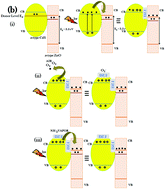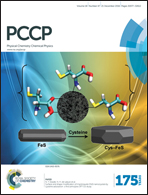Band alignment and depletion zone at ZnO/CdS and ZnO/CdSe hetero-structures for temperature independent ammonia vapor sensing†
Abstract
An optical-fiber based evanescent ammonia vapor sensor was constructed with surface-passivated growth of zinc oxide (ZnO) nanostructures, which was achieved through a three-step wet chemical process. Initially, the ZnO nanostructures were synthesized using a wet-chemical method and subsequently surface-passivated with chalcogenide material compounds namely cadmium sulphide (CdS) and cadmium selenide (CdSe) nanoparticles individually using a citric acid assisted chemical synthesis technique. Finally, surface-passivated ZnO was deposited on the cladding modified optical-fiber using a dip coating process. X-ray diffraction (XRD), tunneling electron microscopy (TEM), energy dispersive spectroscopy (EDS), and X-ray photoelectron spectroscopy (XPS) analyses confirmed the growth of CdS and CdSe nanoparticles on the surface of ZnO nanoparticles. The atomic composition and the full width at half maximum (FWHM) of the oxygen O 1s oxidation state represented in the X-ray photoelectron spectra were lower and narrower for ZC2 nanostructures implying that the available surface oxygen had reacted well and promoted the uniform shell-like growth of CdSe nanoparticles on the ZnO. The significance of the surface-passivated ZnO was realized from UV-Vis diffuse reflectance spectroscopy (DRS) and a photo-luminescence (PL) study and was implemented in a room temperature optical-fiber based evanescent ammonia vapor sensor. The nano-sized CdS particles decorated on the surface of ZnO demonstrate a high vapor sensing behavior. The sensing enhancement was nearly 3 times larger than the core–shell like ZnO/CdSe (ZC2) nanostructures and was attributed to the effective interaction of the incident light and the sensing media, the change in the refractive index of the modified cladding regime, the rate of vapor adsorption and the effective charge-carrier transport between the so-formed hetero-junction interfaces. The ZC2 shows insignificant ammonia vapor adsorption and sensing due to decreased free carrier density produced within the ZnO host lattice and an increased potential barrier width between the ZnO/CdSe hetero-structures.


 Please wait while we load your content...
Please wait while we load your content...